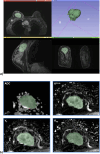Study on heterogeneity of vascularity and cellularity via multiparametric MRI habitat imaging in breast cancer
- PMID: 40361010
- PMCID: PMC12070691
- DOI: 10.1186/s12880-025-01698-x
Study on heterogeneity of vascularity and cellularity via multiparametric MRI habitat imaging in breast cancer
Abstract
Background: This study aimed to visually analyze the heterogeneity of vascularity and cellularity across different sub-regions of breast cancer using habitat imaging (HI) to predict human epidermal growth factor receptor 2 (HER2) expression and evaluate the effectiveness of neoadjuvant therapy (NAT) in breast cancer patients.
Methods: A retrospective analysis was conducted on 76 patients diagnosed with breast cancer. Diffusion-weighted imaging (DWI) and dynamic contrast-enhanced MRI (DCE-MRI) sequences were utilized to acquire MR images. Apparent diffusion coefficient (ADC), Ktrans, Kep, and Ve values were measured for each sub-region, and the percentage of each sub-region relative to the total lesion was calculated. Statistical analyses, including t-tests, rank-sum tests, chi-square tests, and Spearman correlation, were performed.
Results: Three distinct sub-regions within breast cancer lesions were identified through HI, characterized physiologically as: low vascularity-high cellularity (LV-HC), low vascularity-low cellularity (LV-LC), and high vascularity-low cellularity (HV-LC). Significant differences were observed in the proportions of these tumor sub-regions between HER2-positive and HER2-negative breast cancers. Additionally, HER2-low and HER2-zero breast cancers demonstrated statistical differences in the second sub-region (LV-LC). Furthermore, the proportion of the first sub-region (LV-HC) was negatively correlated with the efficacy of NAT in breast cancer patients.
Conclusions: Habitat imaging can identify distinct sub-regions within breast cancer lesions, providing a noninvasive imaging biomarker for predicting HER2 expression levels and assessing the efficacy of NAT in breast cancer patients.
Keywords: Breast cancer; HER2 expression; Habitat imaging; Multiparametric MRI; Tumor heterogeneity.
© 2025. The Author(s).
Conflict of interest statement
Declarations. Ethics approval and consent to participate: Institutional Review Board approval was obtained. This study was approved by the Ethics Committee of the Second Affiliated Hospital of Shantou University Medical College (2020-34), which waived the requirement for written informed consent owing to the use of de-identified retrospective data. The authors confirm that all experiments involving humans and/or the use of human tissue samples were performed in accordance with the Declaration of Helsinki. Consent for publication: Not applicable. Competing interests: The authors declare no competing interests.
Figures





Similar articles
-
Discrimination between HER2-overexpressing, -low-expressing, and -zero-expressing statuses in breast cancer using multiparametric MRI-based radiomics.Eur Radiol. 2024 Sep;34(9):6132-6144. doi: 10.1007/s00330-024-10641-7. Epub 2024 Feb 16. Eur Radiol. 2024. PMID: 38363315
-
Quantitative Parameters of Intravoxel Incoherent Movement Imaging and Dynamic Contrast Enhancement MRI for the Prediction of HER2-Zero, -Low, and -Positive Breast Cancers.Acad Radiol. 2025 Apr;32(4):1851-1860. doi: 10.1016/j.acra.2024.11.011. Epub 2024 Nov 26. Acad Radiol. 2025. PMID: 39592385
-
Diffusion-weighted imaging in addition to contrast-enhanced MRI in identifying complete response in HER2-positive breast cancer.Eur Radiol. 2024 Dec;34(12):7994-8004. doi: 10.1007/s00330-024-10857-7. Epub 2024 Jul 5. Eur Radiol. 2024. PMID: 38967659 Free PMC article.
-
Triple-negative invasive breast cancer on dynamic contrast-enhanced and diffusion-weighted MR imaging: comparison with other breast cancer subtypes.Eur Radiol. 2012 Aug;22(8):1724-34. doi: 10.1007/s00330-012-2425-2. Epub 2012 Apr 17. Eur Radiol. 2012. PMID: 22527371
-
Distinguishing Low Expression Levels of Human Epidermal Growth Factor Receptor 2 in Breast Cancer: Insights from Qualitative and Quantitative Magnetic Resonance Imaging Analysis.Tomography. 2025 Mar 10;11(3):31. doi: 10.3390/tomography11030031. Tomography. 2025. PMID: 40137571 Free PMC article.
References
-
- Sung H, Ferlay J, Siegel RL, Laversanne M, Soerjomataram I, Jemal A, Bray F. Global Cancer statistics 2020: GLOBOCAN estimates of incidence and mortality worldwide for 36 cancers in 185 countries. CA Cancer J Clin. 2021;71(3):209–49. - PubMed
-
- McDonald ES, Clark AS, Tchou J, Zhang P, Freedman GM. Clinical diagnosis and management of breast Cancer. J Nucl Med. 2016;57(Suppl 1):S9–16. - PubMed
MeSH terms
Substances
Grants and funding
LinkOut - more resources
Full Text Sources
Medical
Research Materials
Miscellaneous

